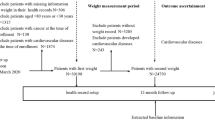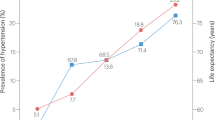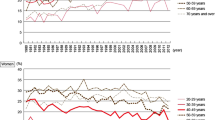Abstract
The prevalence of obesity has increased two to three times from 1975 to 2015. Large-scale epidemiological and longitudinal prospective studies link obesity with hypertension. Research suggests that excessive weight gain, particularly when associated with visceral adiposity, may account for as much as 65% to 75% of the risk of incident hypertension. Also, exercise and bariatric/metabolic surgery significantly lowers blood pressure, whereas weight gain increases blood pressure, thus establishing a firm link between these two factors. The mechanisms underpinning obesity-related hypertension are complex and multifaceted, and include, but are not limited to, renin-angiotensin-aldosterone system/sympathetic nervous system overactivation, overstimulation of adipokines, insulin resistance, immune dysfunction, structural/functional renal, cardiac, and adipocyte changes. Though weight loss is the mainstay of treatment for obesity-related hypertension, it is often not a feasible long-term solution. Therefore, it is recommended that aggressive treatment with multiple antihypertensive medications combined with diet and exercise be used to lower blood pressure and prevent complications. The research regarding the mechanisms and treatment of obesity-related hypertension has moved at a blistering pace over the past ten years. Therefore, the purpose of this expert review is two-fold: to discuss the pathophysiological mechanisms underlying obesity-related hypertension, and to revisit pharmacotherapies that have been shown to be efficacious in patients with obesity-related hypertension.
This is a preview of subscription content, access via your institution
Access options
Subscribe to this journal
Receive 12 digital issues and online access to articles
$119.00 per year
only $9.92 per issue
Buy this article
- Purchase on Springer Link
- Instant access to full article PDF
Prices may be subject to local taxes which are calculated during checkout

Similar content being viewed by others
References
DeMarco VG, Aroor AR, Sowers JR. The pathophysiology of hypertension in patients with obesity. Nat Rev Endocrinol. 2014;10:364.
Kearney PM, Whelton M, Reynolds K, Muntner P, Whelton PK, He J. Global burden of hypertension: analysis of worldwide data. Lancet. 2005;365:217–23.
Hall JE, do Carmo JM, da Silva AA, Wang Z, Hall ME. Obesity, kidney dysfunction and hypertension: mechanistic links. Nat Rev Nephrol. 2019;15:367–85.
Hypertension. https://www.who.int/news-room/fact-sheets/detail/hypertension.
Prevalence of Obesity and Severe Obesity Among Adults: United States, 2017–2018. 2020. https://www.cdc.gov/nchs/products/databriefs/db360.htm.
Cohen JB. Hypertension in obesity and the impact of weight loss. Curr Cardiol Rep. 2017;19:1–8.
Must A, Spadano J, Coakley EH, Field AE, Colditz G, Dietz WH. The disease burden associated with overweight and obesity. JAMA. 1999;282:1523–9.
Bramlage P, Pittrow D, Wittchen H-U, Kirch W, Boehler S, Lehnert H, et al. Hypertension in overweight and obese primary care patients is highly prevalent and poorly controlled. Am J Hypertens. 2004;17:904–10.
Neter JE, Stam BE, Kok FJ, Grobbee DE, Geleijnse JM. Influence of weight reduction on blood pressure: a meta-analysis of randomized controlled trials. Hypertension. 2003;42:878–84.
Juhola J, Oikonen M, Magnussen CG, Mikkilä V, Siitonen N, Jokinen E, et al. Childhood physical, environmental, and genetic predictors of adult hypertension: the cardiovascular risk in young Finns study. Circulation. 2012;126:402–9.
Perez-Pozo SE, Schold J, Nakagawa T, Sánchez-Lozada LG, Johnson RJ, Lillo JL. Excessive fructose intake induces the features of metabolic syndrome in healthy adult men: role of uric acid in the hypertensive response. Int J Obes. 2010;34:454–61.
Khitan Z, Kim DH. Fructose: a key factor in the development of metabolic syndrome and hypertension. J Nutr Metab. 2013;682673.
Kotsis V, Nilsson P, Grassi G, Mancia G, Redon J, Luft F, et al. New developments in the pathogenesis of obesity-induced hypertension. J Hypertens. 2015;33:1499–508.
He D, Fu M, Miao S, Hotta K, Chandak GR, Xi B. FTO gene variant and risk of hypertension: a meta-analysis of 57,464 hypertensive cases and 41,256 controls. Metabolism. 2014;63:633–9.
Rankinen T, Sarzynski MA, Ghosh S, Bouchard C. Are there genetic paths common to obesity, cardiovascular disease outcomes, and cardiovascular risk factors? Circ Res. 2015;116:909–22.
Cabandugama PK, Gardner MJ, Sowers JR. The renin angiotensin aldosterone system in obesity and hypertension: roles in the cardiorenal metabolic syndrome. Med Clin. 2017;101:129–37.
Engeli S, Sharma AM. The renin-angiotensin system and natriuretic peptides in obesity-associated hypertension. J Mol Med. 2001;79:21–9.
Ian Phillips M, Speakman EA, Kimura B. Levels of angiotensin and molecular biology of the tissue renin angiotensin systems. Regulatory Pept. 1993;43:1–20.
Yiannikouris F, Gupte M, Putnam K, Thatcher S, Charnigo R, Rateri DL, et al. Adipocyte deficiency of angiotensinogen prevents obesity-induced hypertension in male mice. Hypertension. 2012;60:1524–30.
Engeli S, Böhnke J, Gorzelniak K, Janke JR, Schling P, Bader M, et al. Weight loss and the renin-angiotensin-aldosterone system. Hypertension. 2005;45:356–62.
Nehme A, Zouein FA, Deris Zayeri Z, Zibara K. An update on the tissue renin angiotensin system and its role in physiology and pathology. J Cardiovasc Dev Dis. 2019;6:14.
Ferrario CM, Ahmad S, Nagata S, Simington SW, Varagic J, Kon N, et al. An evolving story of angiotensin-II-forming pathways in rodents and humans. Clin Sci. 2014;126:461–9.
Seravalle G, Grassi G. Sympathetic nervous system, hypertension, obesity and metabolic syndrome. High Blood Press Cardiovasc Prev. 2016;23:175–9.
Charkoudian N, Rabbitts JA. Sympathetic neural mechanisms in human cardiovascular health and disease. Mayo Clinic Proc. 2009;84:822–30.
Rumantir MS, Vaz M, Jennings GL, Collier G, Kaye DM, Seals DR, et al. Neural mechanisms in human obesity-related hypertension. J Hypertens. 1999;17:1125–33.
Ferrara LA, Moscato TS, Pisanti N, Marotta T, Krogh V, Capone D, et al. Is the sympathetic nervous system altered in children with familial history of arterial hypertension? Cardiology. 1988;75:200–5.
McCrory WW, Klein AA, Rosenthal RA. Blood pressure, heart rate, and plasma catecholamines in normal and hypertensive children and their siblings at rest and after standing. Hypertension. 1982;4:507–13.
Hall JE, da Silva AA, do Carmo JM, Dubinion J, Hamza S, Munusamy S, et al. Obesity-induced hypertension: role of sympathetic nervous system, leptin, and melanocortins. J Biol Chem. 2010;285:17271–6.
Kassab S, Kato T, Wilkins FC, Chen R, Hall JE, Granger JP. Renal denervation attenuates the sodium retention and hypertension associated with obesity. Hypertension. 1995;25:893–7.
Grassi G, Dell'Oro R, Facchini A, Trevano FQ, Bolla GB, Mancia G. Effect of central and peripheral body fat distribution on sympathetic and baroreflex function in obese normotensives. J Hypertens. 2004;22:2363–9.
Zhao S, Zhu Y, Schultz RD, Li N, He Z, Zhang Z, et al. Partial leptin reduction as an insulin sensitization and weight loss strategy. Cell Metab. 2019;30:706–19. e6
Poetsch MS, Strano A, Guan K. Role of leptin in cardiovascular diseases. Front Endocrinol. 2020;11:354.
Sweeney G. Cardiovascular effects of leptin. Nat Rev Cardiol. 2010;7:22.
Bravo PE, Morse S, Borne DM, Aguilar EA, Reisin E. Leptin and hypertension in obesity. Vasc Health Risk Manag. 2006;2:163.
Anderson EA, Hoffman R, Balon T, Sinkey C, Mark A. Hyperinsulinemia produces both sympathetic neural activation and vasodilation in normal humans. J Clin Investig. 1991;87:2246–52.
Velloso LA, Folli F, Perego L, Saad MJ. The multi‐faceted cross‐talk between the insulin and angiotensin II signaling systems. Diabetes/Metab Res Rev. 2006;22:98–107.
Zhou M-S, Wang A, Yu H. Link between insulin resistance and hypertension: what is the evidence from evolutionary biology? Diabetol Metab Syndr. 2014;6:1–8.
Harrison DG, Marvar PJ, Titze JM. Vascular inflammatory cells in hypertension. Front Physiol. 2012;3:128.
Chylikova J, Dvorackova J, Tauber Z, Kamarad V. M1/M2 macrophage polarization in human obese adipose tissue. Biomed Pap Med Fac Univ Palacky Olomouc Czech Repub. 2018;162:79–82.
Aroor AR, McKarns S, DeMarco VG, Jia G, Sowers JR. Maladaptive immune and inflammatory pathways lead to cardiovascular insulin resistance. Metabolism. 2013;62:1543–52.
Konukoglu D, Uzun H. Endothelial dysfunction and hypertension. Adv Exp Med Biol. 2017;956:511–40.
Lee I, Kim S, Nagar H, Choi S-j, Jeon BH, Piao S, et al. CR6-interacting factor 1 deficiency reduces endothelial nitric oxide synthase activity by inhibiting biosynthesis of tetrahydrobiopterin. Sci Rep. 2020;10:1–13.
Chang L, Garcia-Barrio MT, Chen YE. Perivascular adipose tissue regulates vascular function by targeting vascular smooth muscle cells. Arterioscler Thromb Vasc Biol. 2020;40:1094–109.
Dimitrova R, Petkova V, Dimitrov M, Madzharov V, Nikolova I, Petkova E, et al. Obesity-relationship with vascular dysfunction. Adv Obes Weight Manag Control. 2014;1:1–5.
Engin A. Endothelial dysfunction in obesity. In: Obesity and lipotoxicity; 2017. p. 345–79.
Hirohama D, Fujita T. Evaluation of the pathophysiological mechanisms of salt-sensitive hypertension. Hypertension Res. 2019;42:1848–57.
Grigoraș A, Balan RA, Căruntu I-D, Giușcă SE, Lozneanu L, Avadanei RE, et al. Perirenal adipose tissue—current knowledge and future opportunities. J Clin Med. 2021;10:1291.
Brady TM. The role of obesity in the development of left ventricular hypertrophy among children and adolescents. Curr Hypertens Rep. 2016;18:3.
Eckel RH, Grundy SM, Zimmet PZ. The metabolic syndrome. Lancet. 2005;365:1415–28.
Kang YE, Kim JM, Joung KH, Lee JH, You BR, Choi MJ, et al. The roles of adipokines, proinflammatory cytokines, and adipose tissue macrophages in obesity-associated insulin resistance in modest obesity and early metabolic dysfunction. PLoS ONE. 2016;11:e0154003.
Liu Z, Liang S, Que S, Zhou L, Zheng S, Mardinoglu A. Meta-analysis of adiponectin as a biomarker for the detection of metabolic syndrome. Front Physiol. 2018;9:1238.
Ohashi K, Parker JL, Ouchi N, Higuchi A, Vita JA, Gokce N, et al. Adiponectin promotes macrophage polarization toward an anti-inflammatory phenotype. J Biol Chem. 2010;285:6153–60.
Chan MT, Wang CY, Seet E, Tam S, Lai HY, Chew EF, et al. Association of unrecognized obstructive sleep apnea with postoperative cardiovascular events in patients undergoing major noncardiac surgery. JAMA. 2019;321:1788–98.
Sarkar P, Mukherjee S, Chai-Coetzer CL, McEvoy RD. The epidemiology of obstructive sleep apnoea and cardiovascular disease. J Thorac Dis. 2018;10:S4189.
Dewan NA, Nieto FJ, Somers VK. Intermittent hypoxemia and OSA: implications for comorbidities. Chest. 2015;147:266–74.
Gottlieb DJ, Punjabi NM. Diagnosis and management of obstructive sleep apnea: a review. Jama. 2020;323:1389–400.
Landsberg L, Aronne LJ, Beilin LJ, Burke V, Igel LI, Lloyd‐Jones D, et al. Obesity‐related hypertension: Pathogenesis, cardiovascular risk, and treatment—a position paper of The Obesity Society and the American Society of Hypertension. Obesity. 2013;21:8–24.
Gorostegi-Anduaga I, Corres P, MartinezAguirre-Betolaza A, Pérez-Asenjo J, Aispuru GR, Fryer SM, et al. Effects of different aerobic exercise programmes with nutritional intervention in sedentary adults with overweight/obesity and hypertension: EXERDIET-HTA study. Eur J Prevent Cardiol. 2018;25:343–53.
Kucharska A, Gajewska D, Kiedrowski M, Sinska B, Juszczyk G, Czerw A, et al. The impact of individualised nutritional therapy according to DASH diet on blood pressure, body mass, and selected biochemical parameters in overweight/obese patients with primary arterial hypertension: a prospective randomised study. Kardiol Pol. 2018;76:158–65.
Ahmadi N, Eshaghian S, Huizenga R, Sosnin K, Ebrahimi R, Siegel R. Effects of intense exercise and moderate caloric restriction on cardiovascular risk factors and inflammation. Am J Med. 2011;124:978–82.
Cohen JB, Gadde KM. Weight loss medications in the treatment of obesity and hypertension. Curr Hypertens Rep. 2019;21:16.
James WPT, Astrup A, Finer N, Hilsted J, Kopelman P, Rössner S, et al. Effect of sibutramine on weight maintenance after weight loss: a randomised trial. Lancet. 2000;356:2119–25.
Greenway FL, Aronne LJ, Raben A, Astrup A, Apovian CM, Hill JO, et al. A randomized, double‐blind, placebo‐controlled study of Gelesis100: a novel nonsystemic oral hydrogel for weight loss. Obesity. 2019;27:205–16.
Sharretts J, Galescu O, Gomatam S, Andraca-Carrera E, Hampp C, Yanoff L. Cancer risk associated with lorcaserin—the FDA’s review of the CAMELLIA-TIMI 61 trial. N Engl J Med. 2020;383:1000–2.
Kuo HH, Wang KT, Lee YH, Lin PL, Liu ME, Lin CY, et al. Effects of lorcaserin on cardiometabolic risk factors in overweight and obese patients: a systematic review and meta‐analysis. J Clin Pharm Ther. 2020;45:35–44.
Wiggins T, Guidozzi N, Welbourn R, Ahmed AR, Markar SR. Association of bariatric surgery with all-cause mortality and incidence of obesity-related disease at a population level: a systematic review and meta-analysis. PLoS Med. 2020;17:e1003206.
Schiavon CA, Bersch-Ferreira AC, Santucci EV, Oliveira JD, Torreglosa CR, Bueno PT, et al. Effects of bariatric surgery in obese patients with hypertension: the GATEWAY randomized trial (gastric bypass to treat obese patients with steady hypertension). Circulation. 2018;137:1132–42.
Seravalle G, Colombo M, Perego P, Giardini V, Volpe M, Dell’Oro R, et al. Long-term sympathoinhibitory effects of surgically induced weight loss in severe obese patients. Hypertension. 2014;64:431–7.
Chang S-H, Stoll CR, Song J, Varela JE, Eagon CJ, Colditz GA. The effectiveness and risks of bariatric surgery: an updated systematic review and meta-analysis, 2003-2012. JAMA Surg. 2014;149:275–87.
Unger T, Borghi C, Charchar F, Khan NA, Poulter NR, Prabhakaran D, et al. 2020 International Society of Hypertension global hypertension practice guidelines. Hypertension. 2020;75
Francischetti EA, de Abreu VG, da Silva Figueiredo LF, Dezonne RS, Coutinho ESF. Effects of blood pressure lowering agents on cardiovascular outcomes in weight excess patients: a systematic review and meta-analysis. Am J Cardiovasc Drugs. 2020;20:447–70
Messerli FH, Bell DS, Fonseca V, Katholi RE, McGill JB, Phillips RA, et al. Body weight changes with β-blocker use: results from GEMINI. The. Am J Med. 2007;120:610–5.
Carnagarin R, Matthews V, Gregory C, Schlaich MP. Pharmacotherapeutic strategies for treating hypertension in patients with obesity. Expert Opin Pharmacother. 2018;19:643–51.
Zinman B, Wanner C, Lachin JM, Fitchett D, Bluhmki E, Hantel S, et al. Empagliflozin, cardiovascular outcomes, and mortality in type 2 diabetes. N. Engl J Med. 2015;373:2117–28.
Cai X, Yang W, Gao X, Chen Y, Zhou L, Zhang S, et al. The association between the dosage of SGLT2 inhibitor and weight reduction in type 2 diabetes patients: a meta‐analysis. Obesity. 2018;26:70–80.
Wadden TA, Bailey TS, Billings LK, Davies M, Frias JP, Koroleva A, et al. Effect of subcutaneous semaglutide vs placebo as an adjunct to intensive behavioral therapy on body weight in adults with overweight or obesity: the STEP 3 randomized clinical trial. JAMA. 2021;325:1403–13.
Greenway FL, Fujioka K, Plodkowski RA, Mudaliar S, Guttadauria M, Erickson J, et al. Effect of naltrexone plus bupropion on weight loss in overweight and obese adults (COR-I): a multicentre, randomised, double-blind, placebo-controlled, phase 3 trial. Lancet. 2010;376:595–605.
Pi-Sunyer X, Astrup A, Fujioka K, Greenway F, Halpern A, Krempf M, et al. A randomized, controlled trial of 3.0 mg of liraglutide in weight management. N Engl J Med. 2015;373:11–22.
Gadde KM, Allison DB, Ryan DH, Peterson CA, Troupin B, Schwiers ML, et al. Effects of low-dose, controlled-release, phentermine plus topiramate combination on weight and associated comorbidities in overweight and obese adults (CONQUER): a randomised, placebo-controlled, phase 3 trial. Lancet. 2011;377:1341–52.
Sjöström L, Rissanen A, Andersen T, Boldrin M, Golay A, Koppeschaar HP, et al. Randomised placebo-controlled trial of orlistat for weight loss and prevention of weight regain in obese patients. Lancet. 1998;352:167–72.
Acknowledgements
VK was supported by a Roy J. and Lucille A. Carver College of Medicine Summer Fellowship in 2019. JP is a recipient of the Iowa Center for Research for Undergraduates Fellowship and a fellow at the Iowa Biosciences Academy.
Author information
Authors and Affiliations
Contributions
ES, VK, JP, RG, WO, and MC drafted the original manuscript. WO drafted the figure, and VK edited and drafted the table and figures. VK and MC critically revised the manuscript for grammar, and intellectual content. All the authors have read and approved the final manuscript.
Corresponding author
Ethics declarations
Competing interests
The authors declare no competing interests.
Additional information
Publisher’s note Springer Nature remains neutral with regard to jurisdictional claims in published maps and institutional affiliations.
Rights and permissions
About this article
Cite this article
Shams, E., Kamalumpundi, V., Peterson, J. et al. Highlights of mechanisms and treatment of obesity-related hypertension. J Hum Hypertens 36, 785–793 (2022). https://doi.org/10.1038/s41371-021-00644-y
Received:
Revised:
Accepted:
Published:
Issue Date:
DOI: https://doi.org/10.1038/s41371-021-00644-y
This article is cited by
-
Twenty-four-hour ambulatory, but not clinic blood pressure associates with leptin in young adults with overweight or obesity: The African-PREDICT study
Hypertension Research (2024)
-
Dietary determinants of overnutrition among hypertensive patients in southwest Ethiopia: an ordinal regression model
Scientific Reports (2024)
-
Obesity and hypertension from a public health perspective in a small remote island of Okinawa, Japan
Hypertension Research (2023)
-
Effects of adrenergic-stimulated lipolysis and cytokine production on in vitro mouse adipose tissue–islet interactions
Scientific Reports (2022)
-
Cardiovascular Disease Risk Reduction and Body Mass Index
Current Hypertension Reports (2022)



